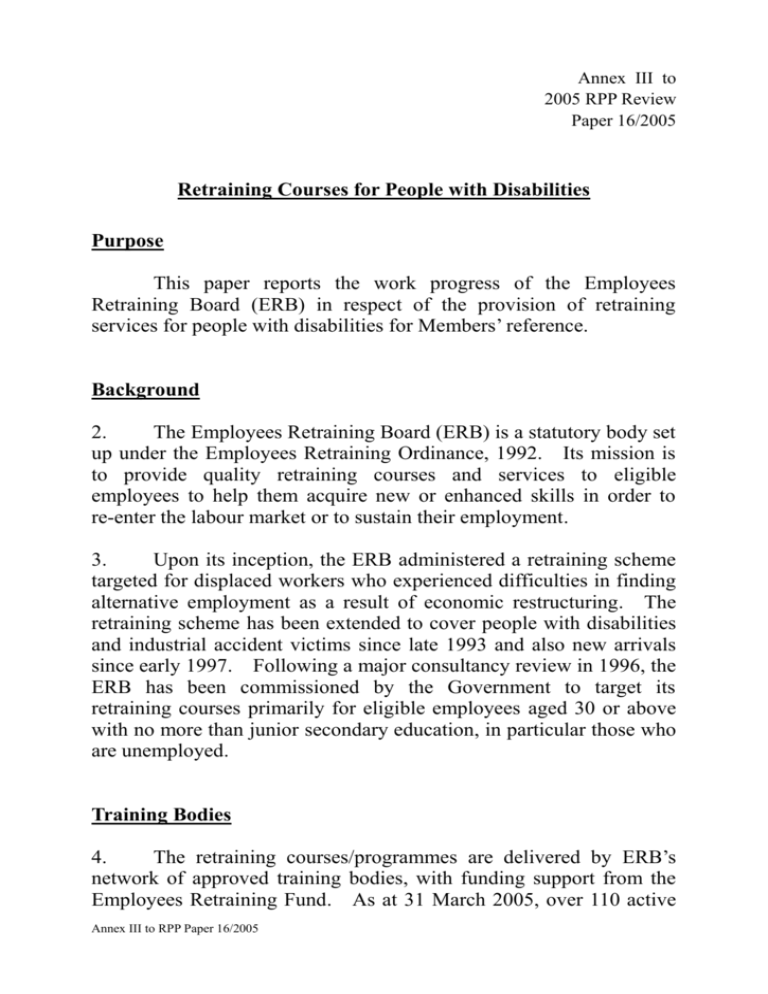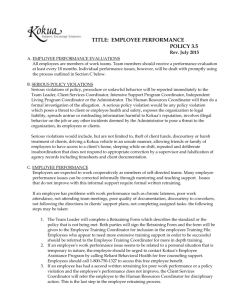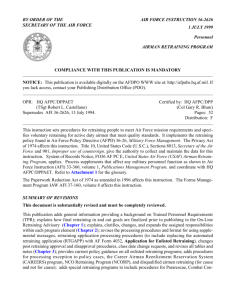The Retraining Programmes
advertisement

Annex III to 2005 RPP Review Paper 16/2005 Retraining Courses for People with Disabilities Purpose This paper reports the work progress of the Employees Retraining Board (ERB) in respect of the provision of retraining services for people with disabilities for Members’ reference. Background 2. The Employees Retraining Board (ERB) is a statutory body set up under the Employees Retraining Ordinance, 1992. Its mission is to provide quality retraining courses and services to eligible employees to help them acquire new or enhanced skills in order to re-enter the labour market or to sustain their employment. 3. Upon its inception, the ERB administered a retraining scheme targeted for displaced workers who experienced difficulties in finding alternative employment as a result of economic restructuring. The retraining scheme has been extended to cover people with disabilities and industrial accident victims since late 1993 and also new arrivals since early 1997. Following a major consultancy review in 1996, the ERB has been commissioned by the Government to target its retraining courses primarily for eligible employees aged 30 or above with no more than junior secondary education, in particular those who are unemployed. Training Bodies 4. The retraining courses/programmes are delivered by ERB’s network of approved training bodies, with funding support from the Employees Retraining Fund. As at 31 March 2005, over 110 active Annex III to RPP Paper 16/2005 retraining courses are being offered through 56 approved training bodies at over 130 centres. Among the training bodies approved for conducting retraining programmes, 15 of them offer courses specifically for people with disabilities. A list of these 15 training bodies is at Appendix 1. The Retraining Programmes 5. A wide range of full-time and part-time retraining programmes are tailor-made for people with disabilities, which can be grouped under two major categories. The first category is full-time placement-tied job specific skills training courses which include, among others, ‘tele-marketing training’, ‘desktop publishing training’, ‘homepage design training’, ‘reception and clerical work training’, ‘cleaning service training’, and ‘shop assistant training’. Another category is basic generic skills training courses, usually offered in part-time mode, such as ‘pre-employment induction training’, ‘computer application training’ and ‘vocational Putonghua training’. Changing Market Needs 6. Subsequent to the gradual economic recovery in 2004, more and more new retraining courses, like those related to retailing and marketing, are being developed to meet changing market needs. For instance, the “Employees Retraining Programme for Early onset Ex-mentally Ill People” and “Sales & Store Management Training” are piloted to provide tailor-made training and employment services for specific groups of the disabled. In October 2004, one of our training bodies offering courses for people with disabilities has obtained recognition from the Security and Guarding Services Industry Authority (SGSIA) to conduct security courses for the disabled. With the recognition from the SGSIA, retrainee gradudates of the approved security courses can promptly apply for a work permit to work as security guards or related jobs upon completion of training. 7. For the current financial year 2005-06, a pilot programme titled “Digital Photography & Video Production Training” has been approved to explore the potential market that may be suitable for the physically handicapped, especially those suffering from lower limb Annex III to RPP Paper 16/2005 2 disabilities. The new course is scheduled for commencement in late 2005 and enrolment of retrainees is now underway. Work Progress 8. Placement-tied retraining programmes also cover adjustment training and follow-up services in order to help the disabled retrainees to find suitable employment and hold down their jobs. From April 2004 to March 2005, a total of 697 retrainees had completed training programmes tailor-made for various categories of the disabled1. A complete list of these tailor-made programmes offered in the financial year 2004-05 is at Appendix 2. A breakdown of the number of retrainees by different categories of disabled persons is at Appendix 3. Funding Principles 9. The ERB provides funding support for retraining programmes on the basis of three guiding principles of cost-effectiveness, client-centred direction and market-driven approach. The retraining programmes, which should be employment-led and market-oriented, are designed to meet specific demands of the job market. In this regard, training bodies are required to identify genuine job vacancies before conducting a retraining programme. With respect to course design, training bodies are also encouraged to involve as much as possible prospective employers in devising course contents and delivery of the programmes. This market-driven approach enables the retraining programmes to be practical, focused and capable of meeting the market needs. The total budget for the retraining programmes for the disabled is over $6 million in 2005-06. Placement 10. Upon completion of a course, the retrainees will be offered placement assistance by relevant training bodies. To strengthen the employment service to the retrainees, training bodies are also The term ‘disabled’ is widely used to include retraining programmes for those who suffer from chronical illness. Annex III to RPP Paper 16/2005 3 1 encouraged to refer them for registration with the Selective Placement Division of the Labour Department for employment assistance. The overall average placement rate for the retraining programmes for the disabled is 64% (April 2004 – January 2005), which is close to our overall benchmark of 70% for all other retraining courses for the able-bodied. Follow-up Services 11. The retraining programmes for people with disabilities place much emphasis on follow-up services to be provided by staff of the training bodies. Services include placement assistance, post-employment follow-up contacts, individual counselling as well as visits to the retrainees in the workplace. 12. Course evaluation has to be conducted by the training body concerned at the end of each course and duly reviewed by ERB. Performance of training bodies in running courses will also be subject to regular review and evaluation by the Quality Assurance Committee as well as the Management Audit and Review Committee of the ERB. 13. Detailed course administration guidelines are provided for all training bodies to help them streamline all procedures related to retraining, such as funding application, vetting of retrainees’ applications, course delivery, placement service and so forth. 14. In order to strengthen communication, ERB also holds periodic Agency Heads Meetings with its training bodies, including those offering programmes for people with disabilities. Such meetings will help facilitate the exchange of information and interflow between ERB and its network of training bodies. Programme of activities for 2005-06 financial year 15. The total training capacity of ERB planned for the financial year 2005-06 is 113 000 places, of which about half are offered on full-time basis. The total number of training places reserved for people with disabilities is 1 000, which is about the same as that of Annex III to RPP Paper 16/2005 4 last year. 16. ERB will sustain its efforts in the provision of retraining programmes tailor-made for people with disabilities. Relevant training bodies are encouraged to take the initiative of submitting new course proposals to ERB in order to tap the market and enhance the training and employment opportunities for the disabled. Employees Retraining Board July 2005 Annex III to RPP Paper 16/2005 5








